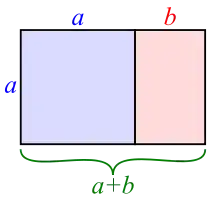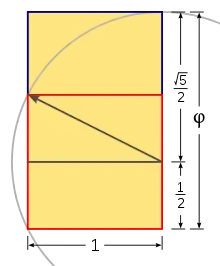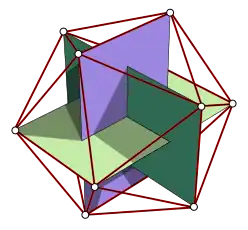
In geometry, a golden rectangle is a rectangle whose side lengths are in the golden ratio, , which is (the Greek letter phi), where is approximately 1.618.
Golden rectangles exhibit a special form of self-similarity: All rectangles created by adding or removing a square from an end are golden rectangles as well.

Construction
A golden rectangle can be constructed with only a straightedge and compass in four steps:
- Drawing a square
- Drawing a line from the midpoint of one side of the square to an opposite corner
- Using that line as the radius to draw an arc that defines the height of the rectangle
- Completing the golden rectangle
A distinctive feature of this shape is that when a square section is added—or removed—the product is another golden rectangle, having the same aspect ratio as the first. Square addition or removal can be repeated infinitely, in which case corresponding corners of the squares form an infinite sequence of points on the golden spiral, the unique logarithmic spiral with this property. Diagonal lines drawn between the first two orders of embedded golden rectangles will define the intersection point of the diagonals of all the embedded golden rectangles; Clifford A. Pickover referred to this point as "the Eye of God".[2]
History
The proportions of the golden rectangle have been observed as early as the Babylonian Tablet of Shamash (c. 888–855 BC),[3][4] though Mario Livio calls any knowledge of the golden ratio before the Ancient Greeks "doubtful".[5]
According to Livio, since the publication of Luca Pacioli's Divina proportione in 1509, "the Golden Ratio started to become available to artists in theoretical treatises that were not overly mathematical, that they could actually use."[6]
The 1927 Villa Stein designed by Le Corbusier, some of whose architecture utilizes the golden ratio, features dimensions that closely approximate golden rectangles.[7]
Relation to regular polygons and polyhedra
Euclid gives an alternative construction of the golden rectangle using three polygons circumscribed by congruent circles: a regular decagon, hexagon, and pentagon. The respective lengths a, b, and c of the sides of these three polygons satisfy the equation a2 + b2 = c2, so line segments with these lengths form a right triangle (by the converse of the Pythagorean theorem). The ratio of the side length of the hexagon to the decagon is the golden ratio, so this triangle forms half of a golden rectangle.[8]
The convex hull of two opposite edges of a regular icosahedron forms a golden rectangle. The twelve vertices of the icosahedron can be decomposed in this way into three mutually-perpendicular golden rectangles, whose boundaries are linked in the pattern of the Borromean rings.[9]
See also
- Fibonacci number – Numbers obtained by adding the two previous ones
- Golden angle -- Circle with sectors in golden ratio
- Golden rhombus – Rhombus with diagonals in the golden ratio
- Kepler triangle – Right triangle related to the golden ratio
- Silver ratio – Ratio of numbers, approximately 1:2.4
- Plastic ratio – Algebraic integer, approximately 1.3247
- Supergolden ratio – Algebraic integer, approximately 1.46557
- Rabatment of the rectangle – Cutting a square from a rectangle
Notes
References
- ↑ Posamentier, Alfred S.; Lehmann, Ingmar (2011). The Glorious Golden Ratio. Prometheus Books. p. 11. ISBN 9-781-61614-424-1.
- ↑ Livio, Mario (2003) [2002]. The Golden Ratio: The Story of Phi, The World's Most Astonishing Number. New York City: Broadway Books. p. 85. ISBN 0-7679-0816-3.
- ↑ Olsen, Scott (2006). The Golden Section: Nature's Greatest Secret. Glastonbury: Wooden Books. p. 3. ISBN 978-1-904263-47-0.
- ↑ Van Mersbergen, Audrey M., Rhetorical Prototypes in Architecture: Measuring the Acropolis with a Philosophical Polemic, Communication Quarterly, Vol. 46, 1998 ("a 'Golden Rectangle' has a ratio of the length of its sides equal to 1:1.61803+. The Parthenon is of these dimensions.")
- ↑ Livio, Mario. "The Golden Ratio in Art: Drawing heavily from The Golden Ratio" (PDF). p. 6. Retrieved 11 September 2019.
- ↑ Livio, Mario (2003) [2002]. The Golden Ratio: The Story of Phi, The World's Most Astonishing Number. New York City: Broadway Books. p. 136. ISBN 0-7679-0816-3.
- ↑ Le Corbusier, The Modulor, p. 35, as cited in Padovan, Richard, Proportion: Science, Philosophy, Architecture (1999), p. 320. Taylor & Francis. ISBN 0-419-22780-6: "Both the paintings and the architectural designs make use of the golden section".
- ↑ Euclid, Euclid's Elements|Elements, Book XIII, Proposition 10.
- ↑ Burger, Edward B.; Starbird, Michael P. (2005). The Heart of Mathematics: An Invitation to Effective Thinking. Springer. p. 382. ISBN 9781931914413..
External links
- Weisstein, Eric W. "Golden Rectangle". MathWorld.
- Weisstein, Eric W. "Golden Ratio". MathWorld.
- The Golden Mean and the Physics of Aesthetics
- Golden rectangle demonstration With interactive animation
- From golden rectangle to golden quadrilaterals Explores some different possible golden quadrilaterals


